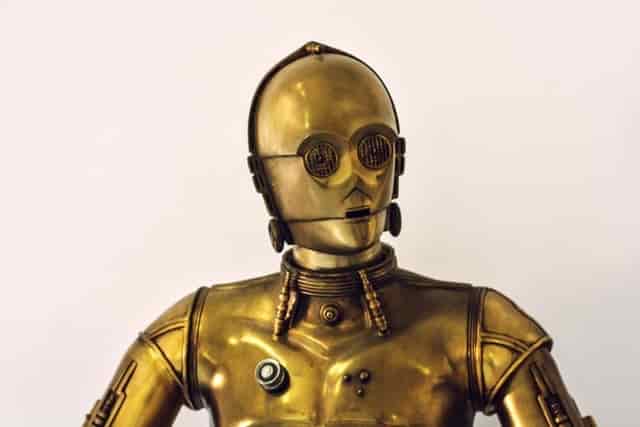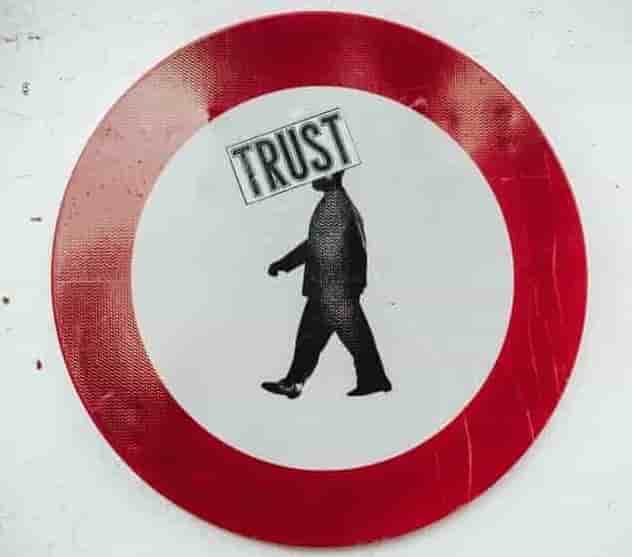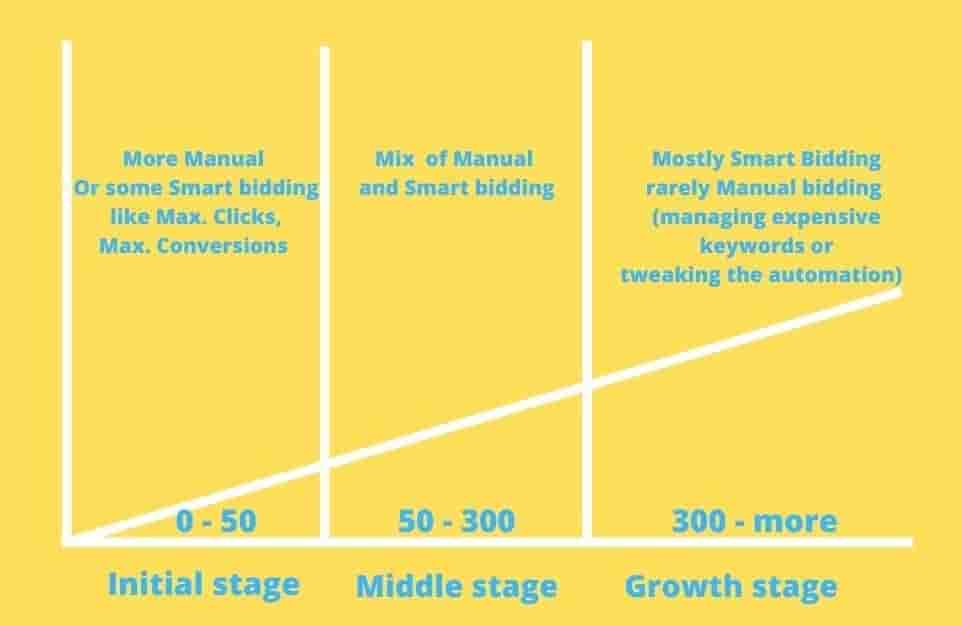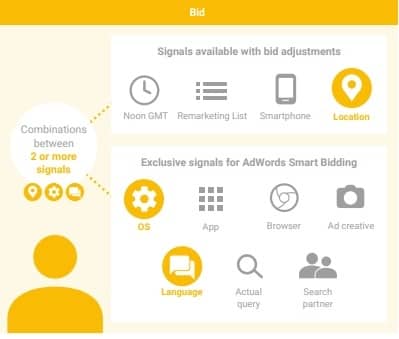Smart Bidding vs Manual Bidding. Which Is Right for you? [Comparison]
![Smart Bidding vs Manual Bidding. Which Is Right for you [Comparison]](https://wuclick.com/wp-content/uploads/2020/12/Smart-Bidding-vs-Manual-Bidding.-Which-Is-Right-for-you-Comparison.jpg)
If you asked this about ten years ago, people would answer this differently.
But, now many things have changed.
People are not skeptical anymore to the automation of Google ads (formerly known as Google AdWords).
Because it is getting better and better every year. And Google is improving its features and adding more sophisticated tools to improve the experience of its customers.
Now, the advertisers are divided into two groups smart bidding vs manual bidding strategy users.
Each group has its own stance and they have enough reasons to defend their way of advertising.
Today, we are going to discuss both of these bidding strategies.
So, If you are curious about which one might be the right fit for your business, keep reading till the end as we are going to make an in-depth comparison.
A brief introduction to both
Smart bidding is a part of Auto-bidding strategies that is probably most used among new and experienced advertisers.

It tries to reduce human intervention and uses Google’s machine learning technology as much as possible.
There are 7 types of smart bidding strategies available:
- Target CPA
- Target ROAS
- Maximize Conversions
- Maximize conversion value (Newly added bidding strategy)
- Maximize Clicks
- Target Impression Share
- Enhanced CPC
Contrary to what most people believe, we added maximize clicks and target impression share as automated smart bidding strategies, because Google itself states them as smart bidding methods on its support page.
Why they are called smart bidding strategies?
Because if you consider adjusting your bids for just a single keyword, there are a lot of possibilities to consider in order to cover every possible scenario from different auctions,
That means you may need to adjust your bids in up to 10 000 ways for just one keyword.
This automated bidding system can manage that much data in real-time. Over time, those generated historical transactions can serve to distinguish between higher and lower probability conversions.
But it is not a perfect system yet.
The Google AI itself doesn’t know surely which keywords and which prices can give you the best bang for your buck. It needs to experience the learning phase first and get some data.
After all, you know the best side of your business and product categories, so you can manage your ads better with some little knowledge.
Manual bidding strategy gives all the responsibility to yourself rather than handing your hard-earned money to some “robot”.

With this strategy, you can set your max. CPC, analyze the user behavior, add to your winners, and cut back your losses, adjust your bids, and more.
For some people, it is what they need. Because it brings full control in their ad spend and they can learn a lot along the way.
Of course, not everything can be manual 100 percent of the time, as there are certain times that you need to use the help of machine learning to reduce the workload or to increase the volume of work.
Smart Bidding vs Manual Bidding Comparison
Pros of Smart bidding:
- Saving your money. There is no extra cost involved if you learn the basics of how to use this method. That means you won’t spend any money on hiring someone to do the manual bidding for you.
- Less time spend. It doesn’t require your attention and full time. You just need to configure it properly at the beginning and that’s it. The AI does its job automatically. From time to time, you can tweak some of the things to improve its performance.
- Managing your campaigns as a group. If you have thousands of keywords in your list, you can spend little to no time managing them by using portfolio strategy (except for enhanced CPC). That means you can set the same bids for several campaigns with one click. You can set those values in prices or percentages.
- Good for large budgets. Automated smart bidding is good for accounts with very large budgets. As it can test a large volume of keywords with different price variations without a hitch. For a given account, it is expected to have a total budget to be at least 10 times of the average conversion value, But, preferably more than 50 times would be great.
- Less emotion involved. In managing your ads manually, you can easily mess things up by being nervous, if your ads won’t bring the necessary result as you expected. Or you might get excited for some of the opportunities and bid on the auctions more than it needs to be and you may blow your monthly budget in a week or even a day. The auto-bidding strategy, on the other hand, is pure automation and changes the bids according to statistics and numbers without emotions.
- Automated bid adjustments. They can make thousands of bid adjustments according to the goals you set, using real-time signals.
Cons of smart bidding:
- Time requirement. Google’s machine learning requires some time to work properly. For some, it may last for a week or if you receive very little traffic, it may last for a month.
- It needs some data. You need at least 15 conversions for some of the strategies to work, otherwise, you won’t be able to use them. And that number is not recommended to get the best results. (But some smart bidding strategies can work with no conversions like Maximize Clicks, Maximize Conversions/Maximize conversion value)
- The negative impact of manual change. If you make some manual changes like changing your landing page or product prices, it may affect negatively the working process. And, it should start the learning process again.
- You can’t set bid prices. As there is limited control, you can’t participate in the auctions directly to change bid prices.
- Restriction in bid adjustments. You can only change device bid adjustments. If you set manual adjustments for other metrics like location demographics, none of your changes are implemented anyway.
- Delayed effect. It may have delays, once you make some changes to your ad account. As a result, you may not be able to see certain results immediately or if you don’t take this into account you could waste some of your money in vain. For example, you started the campaign to sell a product and that product can become out of stock in 1 or 2 days. If somebody goes to your website after 3 days, they leave your page without purchasing anything.
Now, let’s talk about what you can do manually.
Pros of Manual Bidding:
- Full control in the bidding process. You can directly participate in the auctions and change your bids however you want. If you see there is a big chance of conversion, you can bid drastically high to get the best return on ad spend (ROAS). Similarly, you can reduce your bid prices exponentially to test some of your strategies or if you think there is less chance of converting.
- No minimum requirement to run your ads. If you want to start a new campaign, you can start with 0 conversions and start immediately.
- A little budget is enough. There Is no required amount to run your campaigns, you can start with as little as you want, although it is not recommended. A small budget like 500$ to 1000$ a month can hardly bring you enough conversions.
Cons of Manual Bidding:
- Hard to manage. If you have a large number of keywords, you can’t manage them and set the proper bids to achieve your goals. Because sometimes it gets humanly impossible to manage them all by yourself.
- No portfolio bidding. Portfolio bid strategy is not available for manual CPC, so you can’t change your bid prices across multiple campaigns.
- Hard to keep up with new things. Compared to smart bidding you can’t evaluate the big picture. As a result, you may miss new things or can’t see some trends coming in a certain direction.
- Less efficiency. As your account grows, you will become less productive. Because you have the same time and resources to manage more things.
- Human error. It is human nature that you may make mistakes, in setting your max. CPC, adding a wrong keyword or doing some other unexpected error. While with automation, there is no such thing.
Common mistakes done in each strategy
Mistakes in Smart bidding
- Frequent adjustments. As we talked about earlier frequent manual changes to outside factors like website, may interfere with the quality of your ad spend and the costs may go up again. Because the AI has to re-optimize the new data.
- Experimenting. Don’t make experiments with winning campaigns. Instead, run your tests with a small budget and underperforming campaigns.
- Set it and forget it. Smart bidding is not 100 percent automated. You have to take the initial steps like choosing the right strategy, setting your daily budgets, and from time to time adjusting your targets depending on your results.
Mistakes in Manual bidding
- Lack of knowledge. Most people start using this method without any prior knowledge which is a big mistake. If you don’t have any experience using it, then you should stay away from it and use only the automated bidding strategy.
- Broad keywords. When everything depends on you, you should choose more targeted keywords to save your money and increase conversion.
- Only using manual bidding. You should use the help of automated strategies as well. For example, control and bid for as many keywords as you can, and whatever parts you aren’t capable of controlling, you can use the help of maximize clicks strategy.
In which business stages you should use them?
- Initial stage. In this stage, you may have up to 50 conversions a month. Here, you can implement primarily manual and some auto bidding strategies.
- Middle stage. Now, you are going to get conversions from 50 to 300 a month. In this phase, you start applying more automation in your campaigns. But mostly it is going to be a mix of both.
- Growth stage. More than 300 conversions a month. At this stage, things are going to get exciting and you can’t manage your campaigns without automation. There are only a few things that you can do manually. 1) Managing very expensive keywords, 2) Segmenting your products according to their prices to set up different campaigns 3) Doing more A/B tests to learn and experiment with new methods. Other than these, you have to use the smart bidding method.

How to use them both to get the best return from your expenses?
A person who uses both of the strategies in every stage of their business can outperform the one who uses only one of them.
Almost every one of the smart bidding strategies needs some manual tweaks along the way to take advantage of every possibility.
How to optimize your automated bidding to be as controlled as manual bidding?
- In smart bidding strategies, you can change your keyword type from broad to phrase or to exact match keywords and add negative keywords to increase the quality of your ad spend.
- Change your daily budget or your CPC.
- Use the standard or Portfolio bid strategies
- Changing the bid strategies and moving to more advanced ones. Depending on your goals like increasing visits, conversions to your site, or increasing its visibility, its revenue growth across all campaigns, you can choose the right strategy for your business. For example: To focus solely on conversions, start from manual bidding to enhanced CPC, then maximize conversions then target CPA methods.
Run your A/B test for optimal results
Start experimenting with larger campaigns that you can handle.
That campaign should be generating more than 10 percent of the total traffic for your website.
Why we need bigger campaigns? Because the bigger they are, the more data you can generate in a short time period. As a result, you can also split them into 50/50 to test different strategies with enough conversion volume.
Case studies
- OLX is one of the biggest marketplaces for buying and selling goods or services online. According to thinkwithgoogle in a three-week test using smart bidding, it helped their number of conversions to grow 89 percent and reduced the price per conversion to 32 percent.
- International brand Maggi ran a test between Manual search campaigns and automated search campaigns to compare content discoverability. Automated search campaigns have seen 600 percent more visibility and discoverability and reduced their time spent significantly than manual campaigns.
Conclusion
I hope, by now you have a clear understanding of each strategy and when to apply them depending on your situation.
If implemented correctly, these methods can improve your company’s returns exponentially.
Whichever strategy you choose, I wish you happy advertising.
Any questions or comments?
Let me know in the comments section below…
For any help managing your PPC account, you can contact us through our Contact page.


